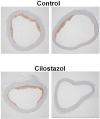Cilostazol inhibits accumulation of triglyceride in aorta and platelet aggregation in cholesterol-fed rabbits
- PMID: 22761774
- PMCID: PMC3382212
- DOI: 10.1371/journal.pone.0039374
Cilostazol inhibits accumulation of triglyceride in aorta and platelet aggregation in cholesterol-fed rabbits
Abstract
Cilostazol is clinically used for the treatment of ischemic symptoms in patients with chronic peripheral arterial obstruction and for the secondary prevention of brain infarction. Recently, it has been reported that cilostazol has preventive effects on atherogenesis and decreased serum triglyceride in rodent models. There are, however, few reports on the evaluation of cilostazol using atherosclerotic rabbits, which have similar lipid metabolism to humans, and are used for investigating the lipid content in aorta and platelet aggregation under conditions of hyperlipidemia. Therefore, we evaluated the effect of cilostazol on the atherosclerosis and platelet aggregation in rabbits fed a normal diet or a cholesterol-containing diet supplemented with or without cilostazol. We evaluated the effects of cilostazol on the atherogenesis by measuring serum and aortic lipid content, and the lesion area after a 10-week treatment and the effect on platelet aggregation after 1- and 10-week treatment. From the lipid analyses, cilostazol significantly reduced the total cholesterol, triglyceride and phospholipids in serum, and moreover, the triglyceride content in the atherosclerotic aorta. Cilostazol significantly reduced the intimal atherosclerotic area. Platelet aggregation was enhanced in cholesterol-fed rabbits. Cilostazol significantly inhibited the platelet aggregation in rabbits fed both a normal diet and a high cholesterol diet. Cilostazol showed anti-atherosclerotic and anti-platelet effects in cholesterol-fed rabbits possibly due to the improvement of lipid metabolism and the attenuation of platelet activation. The results suggest that cilostazol is useful for prevention and treatment of atherothrombotic diseases with the lipid abnormalities.
Conflict of interest statement
Figures





Similar articles
-
Beneficial effect of anti-platelet therapies on atherosclerotic lesion formation assessed by phase-contrast X-ray CT imaging.Int J Cardiovasc Imaging. 2012 Jun;28(5):1181-91. doi: 10.1007/s10554-011-9910-6. Epub 2011 Jun 19. Int J Cardiovasc Imaging. 2012. PMID: 21688134
-
Combination therapy with cilostazol and pravastatin improves antiatherogenic effects in low-density lipoprotein receptor knockout mice.Cardiovasc Ther. 2018 Dec;36(6):e12476. doi: 10.1111/1755-5922.12476. Epub 2018 Nov 29. Cardiovasc Ther. 2018. PMID: 30378752
-
Probucol and cilostazol exert a combinatorial anti-atherogenic effect in cholesterol-fed rabbits.Thromb Res. 2013 Nov;132(5):565-71. doi: 10.1016/j.thromres.2013.09.007. Epub 2013 Sep 13. Thromb Res. 2013. PMID: 24090606
-
The vascular effects of cilostazol.Can J Cardiol. 2006 Feb;22 Suppl B(Suppl B):56B-60B. doi: 10.1016/s0828-282x(06)70987-4. Can J Cardiol. 2006. PMID: 16498513 Free PMC article. Review.
-
Progress in the Mechanism and Clinical Application of Cilostazol.Curr Top Med Chem. 2019;19(31):2919-2936. doi: 10.2174/1568026619666191122123855. Curr Top Med Chem. 2019. PMID: 31763974 Review.
Cited by
-
Cilostazol for Secondary Prevention of Stroke: Should the Guidelines Perhaps Be Extended?Vasc Specialist Int. 2017 Sep;33(3):89-92. doi: 10.5758/vsi.2017.33.3.89. Epub 2017 Sep 30. Vasc Specialist Int. 2017. PMID: 28955697 Free PMC article. Review.
-
Anti-aggregatory effect of boswellic acid in high-fat fed rats: involvement of redox and inflammatory cascades.Arch Med Sci. 2016 Dec 1;12(6):1354-1361. doi: 10.5114/aoms.2016.60675. Epub 2016 Jun 20. Arch Med Sci. 2016. PMID: 27904529 Free PMC article.
-
Probucol inhibits the initiation of atherosclerosis in cholesterol-fed rabbits.Lipids Health Dis. 2013 Nov 4;12:166. doi: 10.1186/1476-511X-12-166. Lipids Health Dis. 2013. PMID: 24188322 Free PMC article.
-
Cilostazol: a Review of Basic Mechanisms and Clinical Uses.Cardiovasc Drugs Ther. 2022 Aug;36(4):777-792. doi: 10.1007/s10557-021-07187-x. Epub 2021 Apr 16. Cardiovasc Drugs Ther. 2022. PMID: 33860901 Review.
-
Allium sativum Compared to Cilostazol as an Inhibitor of Myointimal Hyperplasia.Braz J Cardiovasc Surg. 2016 Jul-Sep;31(4):291-299. doi: 10.5935/1678-9741.20160069. Braz J Cardiovasc Surg. 2016. PMID: 27849301 Free PMC article.
References
-
- Ross R. Atherosclerosis–an inflammatory disease. N Engl J Med. 1999;340:115–126. - PubMed
-
- Sener A, Ozsavci D, Oba R, Demirel GY, Uras F, et al. Do platelet apoptosis, activation, aggregation, lipid peroxidation and platelet-leukocyte aggregate formation occur simultaneously in hyperlipidemia? Clin Biochem. 2005;38:1081–1087. - PubMed
-
- Son DJ, Lee HW, Shin HW, Lee JJ, Yoo HS, et al. Enhanced release of sphingosine-1-phosphate from hypercholesterolemic platelets: role in development of hypercholesterolemic atherosclerosis. Prostaglandins Leukot Essent Fatty Acids. 2008;78:383–390. - PubMed
-
- Davì G, Patrono C. Platelet activation and atherothrombosis. N Engl J Med. 2007;357:2482–2494. - PubMed
-
- Born GV, Hume M. Effects of the numbers and sizes of platelet aggregates on the optical density of plasma. Nature. 1967;215:1027–1029. - PubMed
MeSH terms
Substances
LinkOut - more resources
Full Text Sources
Medical

